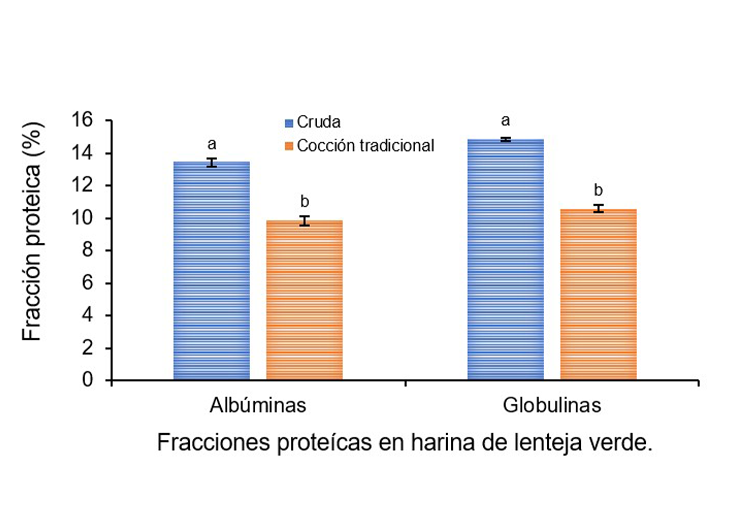Lentil flour as an alternative source of protein
DOI:
https://doi.org/10.29312/remexca.v16i3.3696Keywords:
Lens culinaris M., legumes, protein fractions, protein qualityAbstract
Lentils have a high nutritional value and are sustainably grown, due to their protein content, they are an alternative source of protein. Their transformation into flour would facilitate the development of foods, benefiting their nutritional profile and contributing to the diversification of protein sources. The objective was to evaluate the protein quality of green and red lentil flour. The research was conducted at the Faculty of Chemistry-Pharmacobiology, Morelia, Michoacán in 2023. Lentil flours were obtained by grinding the seeds and by traditional cooking (94 °C). A proximate chemical analysis was performed and protein fractions were determined (Osborne method). Protein quality was determined by Score and PDCAAS. Green lentils are high in protein and fiber, red lentils in carbohydrates and ashes. The protein fractions are the majority and were globulins and albumins, and they decreased after cooking. Red lentil flour presented a better digestibility-corrected amino acid profile, with high Score and PDCAAS. In conclusion, lentil flour is an alternative protein source to develop nutritious foods. Future research could optimize its functional and sensory properties through technologies such as extrusion, expanding its use in caloric-protein diets.
Downloads
References
Arango-Bedoyo, O.; Bolaños-Patiño, V.; Ricaurte-García, D.; Caicedo, M. y Guerrero, Y. 2012. Obtención de un extracto proteico a partir de harina de chachafruto (Erythrina edulis). Revista Universidad y Salud. 14(2):161-167. ISSN 0124-7107.
AOAC. 2005. Association of Officiating Analytical Chemists. Official method of Analysis. 18th Ed. Washington DC, Method 935.14 and 992.24.
Avilés‐Gaxiola, S.; Chuck‐Hernández, C. and Saldívar, S. O. S. 2017. Inactivation methods of trypsin inhibitor in legumes: a review. Journal of Food Science. 83(1):17-29. https://doi.org/10.1111/1750-3841.13985.
Bessada, S. M.; Barreira, J. C. and Oliveira, M. B. P. 2019. Pulses and food security: dietary protein, digestibility, bioactive and functional properties. Trends in Food Science & Technology. 93:53-68. https://doi.org/10.1016/j.tifs.2019.08.022.
Bermejo, C.; Maglia, F.; Palacios, T.; Espósito, M.; Cazzola, F.; Guindón, M.; Gatti, I. and Cointry, E. 2021. Application of different methodologies in lentiL (Lens culinaris M) Breeding. Journal of Basic and Applied Genetics. 32(2):32-39. https://doi.org/10.35407/bag.2021.32.02.04.
Boye, J. I.; Aksay, S.; Roufik, S.; Ribéreau, S.; Mondor, M.; Farnworth, E. and Rajamohamed, S. H. 2009. Comparison of the functional properties of pea, chickpea and lentil protein concentrates processed using ultrafiltration and isoelectric precipitation techniques. Food Research International. 43(2):537-546. https://doi.org/10.1016/j.foodres.2009.07.021.
Chandler, S. L. and McSweeney, M. B. 2022. Characterizing the properties of hybrid meat burgers made with pulses and chicken. International Journal of Gastronomy and Food Science. 27:1-15. https://doi.org/10.1016/j.ijgfs.2022.100492.
Fernandez‐Orozco, R.; Zieliński, H. and Piskuła, M. K. 2003. Contribution of low‐molecular‐weight antioxidants to the antioxidant capacity of raw and processed lentil seeds. Nahrung/Food. 47(5):291-299. https://doi.org/10.1002/food.200390069.
Gallegos-Tintoré, S.; Pacheco-Aguirre, J.; Betancur-Ancona, D. y Chel-Guerrero, L. 2004. Extracción y caracterización de las fracciones proteínicas solubles del grano de Phaseolus lunatus L. Archivos Latinoamericanos de Nutrición. 54(1):81-88. http://ve.scielo.org/scielo.php?script=sci-arttext&pid=S000406222004000100012&lng=es&tlng=es.
Gilani, G. S.; Cockell, K. A. and Sepehr, E. 2021. Effects of antinutritional factors on protein digestibility and amino acid availability in foods. Journal of AOAC International. 88(3):967-987. https://doi.org/10.1093/jaoac/88.3.967.
Kaale, L. D.; Siddiq, M. and Hooper, S. 2022. Lentil (Lens culinaris Medik) as nutrient‐rich and versatile food legume: a review. Legume Science. 5(2):1-11. https://doi.org/10.1002/leg3.169.
Khazaei, H.; Subedi, M.; Nickerson, M.; Martínez-Villaluenga, C. y Vandenberg, A. 2019. Proteína de semilla de lentejas: estado actual, progreso y aplicaciones alimentarias. Revista Alimentos. 8(391):4-23. Doi:10.3390/alimentos8090391.
Kumar, Y.; Basu, S.; Goswami, D.; Devi, M.; Shivhare, U. S. and Vishwakarma, R. K. 2022. Anti-nutritional compounds in pulses: Implications and alleviation methods. Legume Science. 4(2):1-13. https://doi.org/10.1002/LEG3.111.
Lam, A. C. Y.; Karaca, A. C.; Tyler, R. T. and Nickerson, M. T. 2016. Pea protein isolates: structure, extraction, and functionality. Food Reviews International. 34(2):126-147. https://doi.org/10.1080/87559129.2016.1242135.
Lynch, H.; Johnston, C. and Wharton, C. 2018. Plant-based diets: considerations for environmental impact, protein quality, and exercise performance. Nutrients. 10(12):1841-1847. https://doi.org/10.3390/nu10121841.
Martín-Cabrejas, M. A. 2019. Chapter 1. Legumes: an overview. In food chemistry, function and analysis. 1-18 pp. https://doi.org/10.1039/9781788015721-00001.
Mefleh, M.; Pasqualone, A.; Caponio, F. and Faccia, M. 2021. Legumes as basic ingredients in the production of dairy‐free cheese alternatives: a review. Journal of the Science of Food and Agriculture. 102(1):8-18. https://doi.org/10.1002/jsfa.11502.
Meenal, D. A.; Kushwaha, A.; Dobhal, N.; Durgapal, S.; Shahi, N.; Kumar, A. 2023. Assessment of physical, nutritional, antioxidant, antinutritional and cooking characteristics of lentil cultivar PL 8. Asian Journal of Dairy and Food Research, Of. https://doi.org/10.18805/ajdfr.dr-2056.
Norma Oficial Mexicana NOM-247-SSA1. 2008. Productos y servicios. Cereales y sus productos. Cereales, harinas de cereales, sémolas o semolinas. Alimentos a base de: cereales, semillas comestibles, de harinas, sémolas o semolinas o sus mezclas. Productos de panificación.
Osborne, T. B. 1924. The vegetable proteins. London, longmans, greece, and Co. 73-81 pp.
Prada, O. J.; Diaz, O. L. and Rocha, K. T. 2024. Common duckweed (Lemna minor): food and environmental potential. Review. Revista Mexicana De Ciencias Pecuarias. 15(2):404-424. https://doi.org/10.22319/rmcp.v15i2.6107.
Patto, M. C. V.; Amarowicz, R.; Aryee, A. N. A.; Boye, J. I.; Chung, H.; Martín-Cabrejas, M. A. and Domoney, C. 2019. Achievements and challenges in Improving the nutritional quality of food legumes. Critical Reviews in Plant Sciences. 34(1-3):105-143. https://doi.org/10.1080/07352689.2014.897907.
Ros-Berruzco, G. and Periago-Castón, M. J. 2021. Calidad y composición nutritiva de hortalizas, verduras y legumbres. In tratado de nutrición. 3a, 251-263 pp. Ed. Médica Panamericana.
Reyes-Bautista, R.; Barajas-Segoviano, M.; Flores-Sierra, J. J.; Hernández-Mendoza, G. y Xoca-Orozco, L. Á. 2023. Biopéptidos derivados de los pseudocereales: amaranto, quinoa, chía y trigo sarraceno. Revista Especializada en Ciencias Químico-Biológicas. 26:1-27. https://doi.org/10.22201/fesz.23958723e.2023.616.
Samaranayaka, A. and Khazaei, H. 2024. Lentil: revival of poor man’s meat. In Elsevier eBooks. 201-217 pp. https://doi.org/10.1016/b978-0-323-91652-3.00031-9.
Sáenz-Reyes, J. T.; Muñoz-Flores, H. J.; Ruíz-Rivas, M.; Rueda-Sánchez, A.; Castillo-Quiroz, D. y Reyes, F. C. 2022a. Diagnóstico del cultivo de lenteja en unidades de producción familiar en Michoacán. Revista Mexicana De Ciencias Agrícolas. 27:35-44. https://doi.org/10.29312/remexca.v13i27.3160.
Soto, C. V.; Pérez-Bravo, F. y Mariotti-Celis, M. S. 2023. Cantidad, estabilidad y digestibilidad de hidratos de carbono tras el proceso de extrusión: impacto sobre el índice glicémico de harinas de consumo habitual en Chile. Revista Chilena de Nutrición. 50(2):233-241. https://doi.org/10.4067/s0717-75182023000200233.
Suleiman, M. A.; Amro, B. H.; Gamaa, A. O.; Mohamed, M. E. T.; Elhadi, A. I. E. K.; Abdullahi, H. E. T. y Elfadil, E. B. 2019. Cambios en la digestibilidad total de proteínas, contenido de fracciones y estructura durante la cocción de cultivares de lentejas. Pakistan Journal Nutrition. 7:801-805.
WHO, FAO, UNU. 2007. Protein and amino acid requirements in human nutrition: report of a Joint WHO/FAO/UNU Expert Consultation. 1Geneva, Switzerland: World Health Organization. 103-125 pp.
Wyss, L. G. and Durán-Agüero, S. 2020. Consumo de legumbres y su relación con enfermedades crónicas no transmisibles. Revista Chilena de Nutrición. 47(5):865-869. https://doi.org/10.4067/s0717-75182020000500865.

Published
How to Cite
Issue
Section
License
Copyright (c) 2025 Revista Mexicana de Ciencias Agrícolas

This work is licensed under a Creative Commons Attribution-NonCommercial 4.0 International License.
The authors who publish in Revista Mexicana de Ciencias Agrícolas accept the following conditions:
In accordance with copyright laws, Revista Mexicana de Ciencias Agrícolas recognizes and respects the authors’ moral right and ownership of property rights which will be transferred to the journal for dissemination in open access. Invariably, all the authors have to sign a letter of transfer of property rights and of originality of the article to Instituto Nacional de Investigaciones Forestales, Agrícolas y Pecuarias (INIFAP) [National Institute of Forestry, Agricultural and Livestock Research]. The author(s) must pay a fee for the reception of articles before proceeding to editorial review.
All the texts published by Revista Mexicana de Ciencias Agrícolas —with no exception— are distributed under a Creative Commons License Attribution-NonCommercial 4.0 International (CC BY-NC 4.0), which allows third parties to use the publication as long as the work’s authorship and its first publication in this journal are mentioned.
The author(s) can enter into independent and additional contractual agreements for the nonexclusive distribution of the version of the article published in Revista Mexicana de Ciencias Agrícolas (for example include it into an institutional repository or publish it in a book) as long as it is clearly and explicitly indicated that the work was published for the first time in Revista Mexicana de Ciencias Agrícolas.
For all the above, the authors shall send the Letter-transfer of Property Rights for the first publication duly filled in and signed by the author(s). This form must be sent as a PDF file to: revista_atm@yahoo.com.mx; cienciasagricola@inifap.gob.mx; remexca2017@gmail.
This work is licensed under a Creative Commons Attribution-Noncommercial 4.0 International license.


